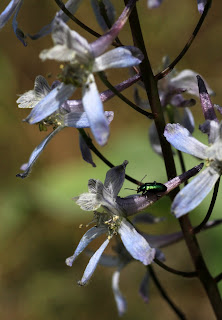Last Friday, May 21st, my wife and I went with eight other members of the WNOS on a fieldtrip to the Leavenworth area, east of the Cascade Mountains. This was the second fieldtrip of the season.
We left home at 5:30 am for the three hour trip but took our time getting to the meeting place, stopping for breakfast in Monroe and for pictures along the way. We went by way of Steven's Pass and Highway 2 and by the time we were through the pass the weather, which started out cloudy, had turned sunny and warm.
We found one interesting flower in the pass, a Trillium that we believe to be an unreported variety of Trillium ovatum. This plant is much smaller than the normal form of T. ovatum, has nodding flowers and a short stem. We found many near the top of the pass just east of the ski area.
We've tentatively identified it as Oettinger's Trillium (Trillium ovatum ssp. oettinger). This subspecies, however, has only been reported from California and someone else may know better regarding the identity of this beautiful plant.
Our fieldtrip began in the town of Trail, Washington, where we organized ourselves at the hardware store under Melissa's capable leadership. There we also met Marti for the first time. I had been in contact with her through Flickr and had invited her along. Marti is very knowledgeable on Washington wildflowers and birds. She's now a member of the WNOS. Her Flickr site is at http://www.flickr.com/photos/meanderingwa/ and she has a wonderful blog at http://meanderingwa.blogspot.com where you can read her version of our trip.
We began our day together just outside the town of Trail where we parked along a hillside road and climbed the hill. We had hoped to see the Phantom Orchid there(Cephalanthera austinae) but its pure white shoots were only a few inches tall and a month from blooming. Further up the hill, however, we found the day's prize, the Brownie or Clustered Lady's Slipper (Cypripedium fasciculatum).
This rare plant is only about 6 inches tall and carries a cluster of two to four flowers that are about an inch in size. On the plants we were privileged to see and photograph, the flowers ranged from greenish to a deep red-brown. There were about a dozen of them growing in the area and we were careful not to step on them or crush them.
.JPG)
From Trail we went through Leavenworth to the town of Peshastin, about fifteen miles further. My wife and I managed to get lost but finally found the others waiting for us at the Derby Canyon Nursery, a wonderful native plant source. Some of the members bought plants there and there were additional opportunities for photos, since many of the plants were in bloom.
Beyond the nursery we followed the Derby Canyon Road, dodging road building equipment until we came to a place, where the leader of our group had previously found a rare red Trillium, Trillium petiolatum, growing.
We found numerous examples of this wonderful plant growing in a rather wet area. The plant is unique in that flowers are found at the base of the leaves, rather than on a stem above the leaves. We took photos there and then moved on a bit further down the Derby Canyon Road.
After parking out of the way of the construction equipment, we climbed the ridge on the north side of the canyon and followed a trail along the top of the ridge passing some rather strange sandstone formations along the way.

Getting close to them and taking photos involved clambering over rocks and through brush and so another hour was consumed before we continued our journey home, arriving back tired and in time for a late evening meal.





+%231.JPG)
+%2311.JPG)











2 comments:
They were certainly worth stopping for. What was amazing to us was the fact that they were growing in detritus and moss on the top of these huge boulders in very little soil.
Post a Comment